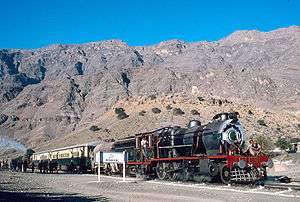Khyber train safari
| Khyber Steam Safari خیبر بخار سفاری | ||||||||||||||||||||||||||||||||||||||||||||||||||||||||||||||||||||||||||
|---|---|---|---|---|---|---|---|---|---|---|---|---|---|---|---|---|---|---|---|---|---|---|---|---|---|---|---|---|---|---|---|---|---|---|---|---|---|---|---|---|---|---|---|---|---|---|---|---|---|---|---|---|---|---|---|---|---|---|---|---|---|---|---|---|---|---|---|---|---|---|---|---|---|---|
| Overview | ||||||||||||||||||||||||||||||||||||||||||||||||||||||||||||||||||||||||||
| Native name | د خیبر تپ صفري | |||||||||||||||||||||||||||||||||||||||||||||||||||||||||||||||||||||||||
| Status | Suspended[1] | |||||||||||||||||||||||||||||||||||||||||||||||||||||||||||||||||||||||||
| Termini |
Peshawar City Landi Kotal | |||||||||||||||||||||||||||||||||||||||||||||||||||||||||||||||||||||||||
| Stations | 5 | |||||||||||||||||||||||||||||||||||||||||||||||||||||||||||||||||||||||||
| Operation | ||||||||||||||||||||||||||||||||||||||||||||||||||||||||||||||||||||||||||
| Opened | 1894[2] | |||||||||||||||||||||||||||||||||||||||||||||||||||||||||||||||||||||||||
| Closed | July 26, 2011[2] | |||||||||||||||||||||||||||||||||||||||||||||||||||||||||||||||||||||||||
| Owner | Pakistan Railways | |||||||||||||||||||||||||||||||||||||||||||||||||||||||||||||||||||||||||
| Operator(s) | Pakistan Railways | |||||||||||||||||||||||||||||||||||||||||||||||||||||||||||||||||||||||||
| Technical | ||||||||||||||||||||||||||||||||||||||||||||||||||||||||||||||||||||||||||
| Line length | 58 km (36 mi)[3] | |||||||||||||||||||||||||||||||||||||||||||||||||||||||||||||||||||||||||
| ||||||||||||||||||||||||||||||||||||||||||||||||||||||||||||||||||||||||||
Khyber Steam Safari (Urdu: خیبر بخار سفاری, Pashto: د خیبر تپ صفري) was a tourist railway, operated and maintained by Pakistan Railways. The line began at Peshawar City and ended at Landi Kotal, passing through the historic Khyber Pass. The total length of this railway line is 52 kilometers (32 mi) with 5 railway stations, 34 tunnels and 92 bridges and culverts.
History


The Khyber Steam Safari had been described as "a journey into time and history." The train consisted of one parlour car and two second class coaches pulled by two vintage steam locomotives that took tourists through rugged mountainous terrain. The train covered a total of 52 kilometres (32 mi) through 34 tunnels and 92 bridges and culverts. The 1920s model vintage oil-fired steam engines, which pushed and pulled the carriages from the rear and front, were built by Vulcan Foundry and by Kitson & Co in the United Kingdom.[4] The steam safari climbed more than 1,200 m (3,900 ft) to reach Landi Kotal. One of the unusual features of this train journey is that its path passes through the Peshawar Airport runway. (Other examples can be found at Manakara Airport in Madagascar and Gisborne Airport in New Zealand.[5]) The train was run on the first Sunday of every month and on charter. The local population was allowed free rides. The Khyber Train Safari experienced the ups-and-downs of the times. It was built as a strategic line to thwart any Afghan or Russian invasion of British India. The railway was officially opened on 3 November 1925 during the British Raj. The wife of Victor Bayley, the engineer who was assigned the construction of the line, had previously driven the first train into Landi Kotal.[6] After Pakistan's independence in 1947 a weekly train was started between Peshawar and Landi Kotal, running every Sunday. Train operations were stopped in 1982, as the railway was not commercially viable. However, in the 1990s, a tourist train, the Khyber Train Safari, was launched by a private enterprise in collaboration with Pakistan Railways. It was closed in 2006 after a flood washed away railway track and bridges.
Stations
See also
References
- ↑ Khyber Pass Railway Author: Owais Mughal, Publisher: http://pakistaniat.com , Retrieved on 15 July 2012
- 1 2 Sohail Khan (November 14, 2011). "Bahawalnagar rail junction a relic from 1901". The Nation. BAHAWALNAGAR. Archived from the original on October 1, 2016. Retrieved 1 October 2016.
- ↑ "Pakistan Railways Time & Fare Table 2015" (PDF). Musafir (in English and Urdu). Pakistan. October 2015: 106 (50). Retrieved 18 August 2016.
- ↑ Hughes, H. (1990) Indian locomotives: Part 1 - Broad Gauge 1851-1940 Harrow: The Continental Railway Circle.
- ↑ Shah, Syed Inayat Ali The derailed safari train The Daily Jang jang.com.pk Retrieved on 20 September 2005
- ↑ Bayley, Victor (1939). Permanent Way Through the Khyber. London: Jarrold.